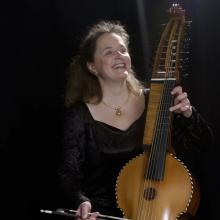E-mail: vorname.nachname@dr-hochs.de
Roswitha Bruggaier
Violoncello, Baroque violoncello, Viola da gamba
1. Education and Career
She was born in Frankfurt in 1962. At the age of 5 she received her first recorder and piano lessons from her father, and at the age of 11 she received violoncello tuition from Mechtild Wagner in Frankfurt. She studied music education at the Frankfurt School of Music and Performing Arts from 1981 to 1985 (learning violoncello with Prof. Jörg Wiederhold, piano with Prof. Bernd Ickert, choral conducting with Prof. Alois Ickstadt), and in 1985 she passed the 1st state examination. She then attended a course of artistic training in violoncello with Prof. Gerhard Mantel.
1989 "Künstlerische Reifeprüfung" with "diplom".
She attended viola da gamba classes with Rainer Zipperling.
She received further training at various master courses: violoncello with Martin Ostertag and Klaus Heitz, Baroque cello and viola da gamba with Anner Bylsma, Wouter Möller, Lidewij Scheifes and Jaap ter Linden.
She has taught violoncello, Baroque cello and viola da gamba at Dr. Hoch’s Conservatory since 1989.
She was taught classical North Indian music by Partha Chatterjee, Calcutta.
She has been playing the Baroque baryton (viola paradon) since 2004, and the classical baryton since 2008.
2. Activities
She has played viola da gamba and Baroque cello in the ensemble, "Le Goût Étranger" since 1994 (www.le-gout-etranger.com), and she has been playing with the Cologne ensemble, "ornamente 99“, since 2006 (www.ornamente99.com). She has made radio recordings with HR and SR, and carries out a wide variety of performances and teaching.
Member of the "Johann Strauß Orchestra Frankfurt".
She worked on the stage production of Bach's "St. John's Passion" 2005-6 in the State Theatre Wiesbaden (directed by Dietrich Hilsdorf, musical direction Sébastien Rouland) in the role of St. Cecilia.
From 1987 to 2003 she directed the church choir of St. Mary's, Königstein, and since 1993 she has directed the church choir of St. Joseph, Eschersheim, and since 2003 the church choir of St. Vitus in Kronberg-Oberhöchstadt.
From 1990 to 1994 she formed and directed the "Hessen Doctors' Orchestra".
In 1996, she founded the ensemble, "Dr. Hoch's Philharmonic Cellists" as part of her teaching there. She has made her own adaptations of many pieces for the ensemble. She has performed at the Conservatory and outside.
She published a collection of Christmas songs for violoncello ensemble with Zimmermann (ZM 33540) and the "Cello-(Phil)Vielharmonie" with Breitkopf & Härtel (KM 2288).
3. Aims
She prefers to start teaching shortly before the start of schooling. This starting age has proven to be effective as the children approach the instrument without any preconceptions and grow up with it. As our music culture is written, after initial phases of improvisation and play, she passes relatively quickly to reading and writing music. If other family members play an instrument, she will look for pieces for them to play together, and if necessary writes short arrangements on a computer (e.g., songs with very simple accompaniment). With older children, young people and adults she starts with written music straight away, working with individually produced teaching programmes. She also believes it is important to explain movements and physiological aspects of the instrument, and make it possible to experience them directly (as expounded by Prof. Gerhard Mantel).
Playing together is important in her teaching. The piano has proven to be an effective support for intonation than a second cello (played by her) as the tone colourings can be better distinguished and more reliable support is provided for intonation. "Real music" is made right from the first moment (playing together with open strings from the first class).
She also believes it is very important for the pupils to play together, and pupils with lessons following each other often play together in the time between the individual lessons. This also assists with reading music. Playing with the violoncello ensemble, "Dr. Hoch's Philharmonic Cellists" is of course an incentive that encourages practice…
Her teaching emphasises stylistic variety and - particularly with advanced pupils - appropriate stylistic interpretation. This can also be taught effectively to young pupils, who then become attentive, critical concert audiences.
Contact with various styles can lead to contact with the Baroque cello, although this is not obligatory.
The Baroque violoncello is not related to the viola da gamba and it overlaps in the repertoire as a basso continuo instrument. The solo cello literature from the Baroque period is sometimes also played by "modern" cellists, and this is even frequently the case for the suites of Johann Sebastian Bach. However, it is not just the way the instrument is held and the way that the bow is used that are different, but also the inner posture of the player, in an style-oriented exploration of Baroque music. The Baroque cello offers modes of expression (e.g., in the articulation), which are not offered by the modern cello in this form. This means that working with the Baroque cello is also very enriching for "modern" cellists.
Music for the viola da gamba ranges from consort music and diminutions from Italy and England to German solo and ensemble literature from the 17th and 18th Century, and the grand Baroque solo repertoire of the French (Marais, Forqueray etc.). The different types of instrument can be used in this context (descant, alto, tenor and bass viola da gamba). Playing from original sources is also part of the teaching (different clefs, tablature). The viola da gamba is also used in chamber music in basso continuo.
Further Informations:

